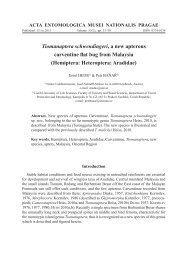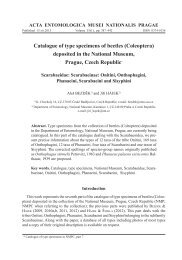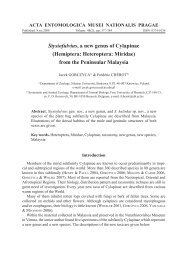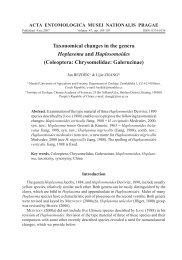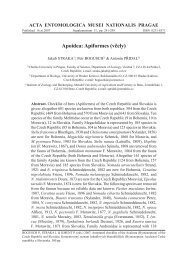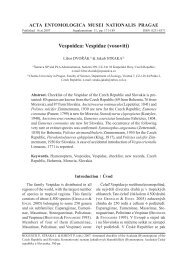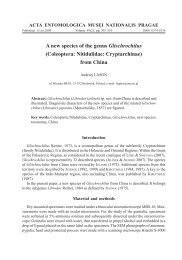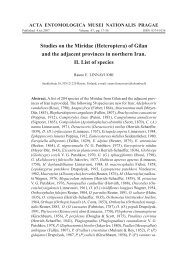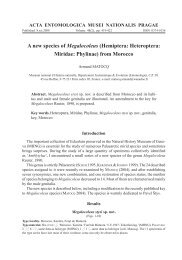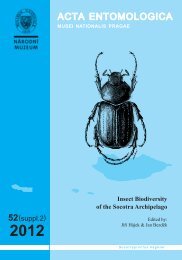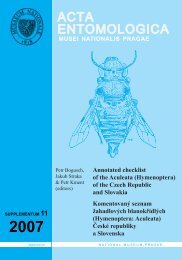Revision of the Palaearctic species of the Coccinella ...
Revision of the Palaearctic species of the Coccinella ...
Revision of the Palaearctic species of the Coccinella ...
You also want an ePaper? Increase the reach of your titles
YUMPU automatically turns print PDFs into web optimized ePapers that Google loves.
Acta Entomologica Musei Nationalis Pragae, 45, 2005 161<br />
armature <strong>of</strong> Spilota are unique in <strong>Coccinella</strong>. The common presence <strong>of</strong> a reduced siphonal<br />
capsule and <strong>the</strong> basal dilatation <strong>of</strong> siphonal tube in <strong>species</strong> <strong>of</strong> Spilota and Ceratomegilla<br />
supports <strong>the</strong> subgeneric status <strong>of</strong> Spilota in <strong>Coccinella</strong> ra<strong>the</strong>r than reducing it to a synonym <strong>of</strong><br />
<strong>Coccinella</strong>.<br />
Therefore, <strong>the</strong> three <strong>species</strong> currently placed in Neococcinella must be classified as follows:<br />
C. (Spilota) alpigrada (Iablok<strong>of</strong>f-Khnzorian), comb. subgen. nov.; C. (Spilota) miranda<br />
Wollaston, comb. subgen. nov.; and C. (Spilota) undecimpunctata Linnaeus, comb. subgen.<br />
nov.<br />
<strong>Coccinella</strong> (Spilota) alpigrada (Iablok<strong>of</strong>f-Khnzorian, 1957) comb. subgen. nov.<br />
Adalia alpigrada Iablok<strong>of</strong>f-Khnzorian, 1957: 170.<br />
<strong>Coccinella</strong> alpigrada: IABLOKOFF-KHNZORIAN (1970a): 70 (male genitalia).<br />
<strong>Coccinella</strong> (Neococcinella) alpigrada: IABLOKOFF-KHNZORIAN (1979): 66 (catalogue); IABLOKOFF-KHNZORIAN (1982):<br />
356.<br />
Material examined. TURKEY: ERZURUM province, (ca 50 km S), Hamzalar – hot springs<br />
(39°27´N, 41°07´E), 1935 m a.s.l., 21.vi.2003, 1 , J. Hájek & J. Hotový leg. (NMPC).<br />
The taxonomy <strong>of</strong> this <strong>species</strong> was treated by IABLOKOFF-KHNZORIAN (1957, 1970a, 1979).<br />
The <strong>species</strong> has been hi<strong>the</strong>rto known only from Armenia and regarded as subalpine, living at<br />
<strong>the</strong> altitude <strong>of</strong> ca 3300 m a.s.l. in Mt. Gogui <strong>of</strong> Sevan Mts. It is here identified as new for<br />
Turkey; <strong>the</strong> specimen lacks spot 1.<br />
IV. <strong>Coccinella</strong> (Chelonitis) venusta (Weise, 1879)<br />
Genus Chelonitis was established by WEISE (1879) for Chelonitis venusta Weise, 1879<br />
differing from o<strong>the</strong>r European Coccinellinae in <strong>the</strong> complete lack <strong>of</strong> <strong>the</strong> additional lateral line<br />
<strong>of</strong> abdominal ventrite 1 and <strong>the</strong> peculiar coloration <strong>of</strong> elytra. SICARD (1907) described an<br />
aberrant form <strong>of</strong> it as ab. adalioides Sicard, 1907 (locality not given). CAPRA (1944) upgraded<br />
Sicard’s name to subspecific status, gave distributional data on both sub<strong>species</strong> and fixed <strong>the</strong><br />
type locality <strong>of</strong> C. adalioides by neotype from coll. F. Solari. IABLOKOFF-KHNZORIAN (1979)<br />
transferred Chelonitis to <strong>Coccinella</strong> and rejected <strong>the</strong> name venusta Weise, 1879 because <strong>of</strong> a<br />
secondary homonymy with C. venusta Melsheimer, 1847. He replaced C. (Ch.) venusta (Weise)<br />
with C. adalioides Capra (attributing it to Sicard) and proposed <strong>the</strong> name C. (Ch.) adalioides<br />
venustula Iablok<strong>of</strong>f-Khnzorian, 1979 for Weise’s taxon. The relationships between names are<br />
in fact more complex. At that time, C. venusta Melsheimer was already transferred to Neoharmonia<br />
sensu Casey, 1899 as its type <strong>species</strong>, designated by TIMBERLAKE (1943). However, <strong>the</strong><br />
genus Neoharmonia was originally proposed by CROTCH (1871) and its type <strong>species</strong> Harmonia<br />
viridipennis Mulsant, 1866 (= Harmonia ampla Mulsant, 1850) was designated by RYE<br />
(1873). It is now classified as Neoharmonia venusta ampla (Mulsant, 1850). Because <strong>the</strong><br />
Nearctic Neoharmonia venusta (Melsheimer 1847) and <strong>the</strong> <strong>Palaearctic</strong> <strong>Coccinella</strong> (Chelonitis)<br />
venusta (Weise, 1879) are not congeneric, <strong>the</strong> junior secondary homonym recognized by



